Sencha Touch beta — Amazing Mobile Web Apps with HTML5, CSS3 & JavaScript
2 likes1,358 views
A presentation reviewing the features, coding style, and demos, given at Silicon Valley Code Camp 2010.
1 of 56
Downloaded 132 times

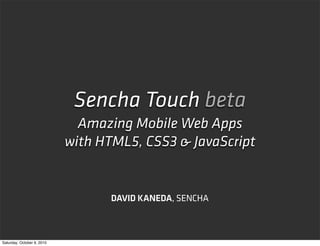
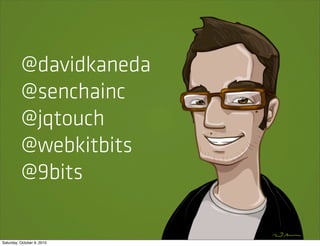

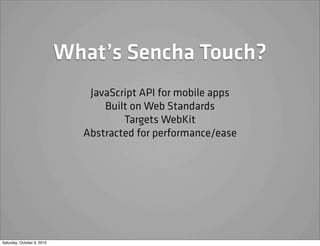



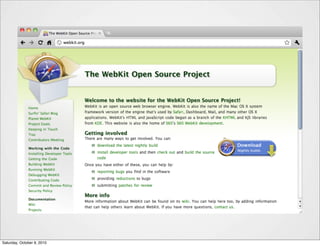


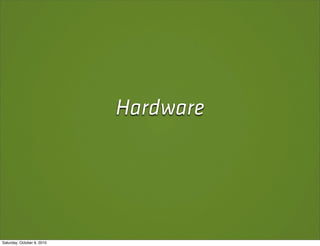




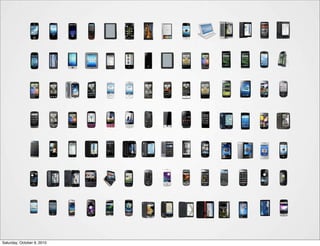







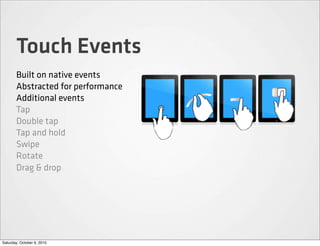













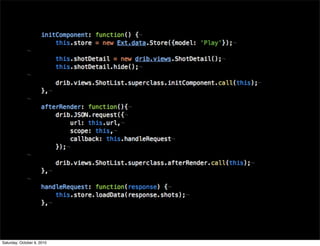


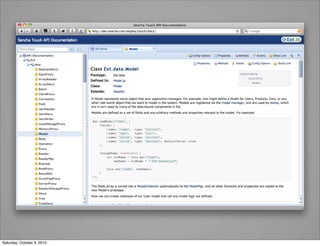







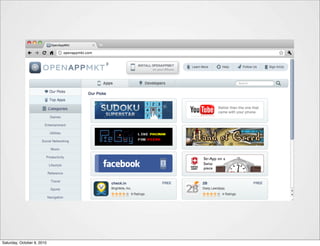






Ad
Recommended
CSS Bloat!



CSS Bloat!Nicole Sullivan Your website has out-of-control CSS bloat. You know your performance is being impacted, but how do you move from organic CSS with no particular architecture to something lighter, more logical, and easier to maintain? In this session, Nicole Sullivan and Stoyan Stefanov will show you how they improved the CSS at Facebook and Yahoo! Search. After this session you will know how to:
1. Use lint tools to automate and evaluate the efficiency of your CSS
2. Avoid the top 5 causes of CSS bloat, and
3. Speed up your site by making the UI code an order of magnitude smaller.
Internet Safety and Digital Citizenship



Internet Safety and Digital CitizenshipWesley Fryer This presentation on Internet Safety and Digital Citizenship was shared by Wesley Fryer with high school students in Alva, Oklahoma, on September 10, 2010. This was one of five presentations Wesley shared with K-12 students in Alva to fulfill eRate requirements for Internet Safety training. Learn more about Wesley's presentations on http://www.speedofcreativity.org/speaking/
Sencha Touch Workshop



Sencha Touch WorkshopDavid Kaneda A 3-hour workshop I gave at Brooklyn Beta, walking through the basics of building a Sencha Touch app. More info at http://9-bits.com/bb2010.
Sencha Touch is a Javascript framework that enables developers to create apps for iOS and Android.
http://sencha.com/products/touch/
Ext GWT 3.0 Theming and Appearances



Ext GWT 3.0 Theming and AppearancesSencha Theming in Ext GWT 3.0 now uses the GWT Appearance pattern and utilizes GWT ClientBundle and CssResource. This session will provide a detailed overview of how theming works and how to extend and create new themes.
Building Sencha Themes



Building Sencha ThemesSencha Learn how to use the power of CSS3, Sass, Compass, and Sencha tools to create consistent and cross-platform themes for Ext JS 4 and Sencha Touch.
David Kaneda leads the Sencha design team. He has over eight years of experience designing in a variety of fields, from architecture and fashion to education and software. Recently, David created Outpost, an iPhone app for Basecamp, and jQTouch, a Javascript framework for iPhone development. David also maintains WebKitBits, a site about the browser engine in Safari, Google Chrome, and the iPhone. David brings his wealth of design knowledge to Sencha, and is responsible for the look and feel of our websites and software.
Rob Dougan is a Sencha core engineer with an eye for pixel-perfect designs. Born and raised in Northern Ireland, he has been building advanced Sencha applications for years and is a valued asset to the team. In his spare time he enjoys photography and cooking with his wife.
How to Develop a Rich, Native-quality User Experience for Mobile Using Web St...



How to Develop a Rich, Native-quality User Experience for Mobile Using Web St...David Kaneda This document discusses how to build rich mobile user experiences using web standards like HTML5, CSS3, and JavaScript. It covers various HTML5 features such as new elements, forms, video/audio, geolocation and caching. It also discusses CSS techniques including transforms, transitions, animations and vendor-specific properties. Challenges with fixed positioning, touch events and performance are addressed. The document promotes building web apps that are native-like using frameworks like jQTouch and Sencha Touch.
Advanced android



Advanced androiddonnfelker This document outlines topics that will be covered in a talk about intermediate Android development. The topics include: using RoboGuice for dependency injection, basic Java unit testing with JUnit, Android unit testing, the Droid-Fu development framework, and using Hudson for continuous integration of Android builds. Code demos will be provided for RoboGuice, JUnit testing, and Droid-Fu. Questions from attendees are welcomed at the end.
RIA Unleashed - Developing for the TV with litl os



RIA Unleashed - Developing for the TV with litl osryancanulla The document discusses developer workflows and tools for building applications for the Litl TV companion device. It covers available inputs like gestures and accelerometer, SDK and simulator tools for building channels, testing apps on an Android or iOS device connected over WiFi, and managing services, views, remotes and accelerometer data through classes like the LitlServiceManager, LitlViewManager and LitlRemoteManager.
OvertheAir 2010 html5 impact on application programming



OvertheAir 2010 html5 impact on application programmingTor Björn Minde The document discusses emerging HTML5 communication technologies and their impact. It covers new technologies like WebSockets and EventSource that enable real-time bidirectional and server-sent events between web apps and servers. It argues this will influence native apps and lead to more interconnected, adaptive and synchronized web experiences across different screens.
HTML5 impact on application programming



HTML5 impact on application programmingEricsson Labs The document discusses emerging HTML5 communication technologies and their impact. It covers new technologies like WebSockets, EventSource, and cross-origin XMLHttpRequest that enable real-time communication. It argues these technologies will influence native apps and lead to more interconnected, adaptive applications that can span devices and automatically synchronize data.
HTML5 Apps - Cross platform



HTML5 Apps - Cross platformwolframkriesing The document discusses HTML5 apps and widgets for mobile devices. It covers topics like JavaScript, CSS, cross-platform development using tools like PhoneGap, differences between W3C widgets and other specifications, and how widgets can access device capabilities. EmbedJS is presented as a tool for building cross-platform widgets using Dojo, and it supports generating code for different mobile platforms from a single codebase.
Human APIs - expanding the mobile web or are robots coming to JavaScript? 



Human APIs - expanding the mobile web or are robots coming to JavaScript? Nikolai Onken These are the slides of the talk I gave at webteccon 2010 in Mainz, Germany. Topic was how we can extend the browser
Vagrant at LA Ruby



Vagrant at LA RubyMitchell Hashimoto Vagrant presentation at LA Ruby in September 2010.
The main takeaway for this presentation I wanted to give was the reasoning and importance for virtualization development environments.
In depth with html5 java2days 2010



In depth with html5 java2days 2010Mystic Coders, LLC The document provides an overview of HTML5 including:
- A brief history of HTML standards from 1991 to the development of HTML5 in 2009.
- An explanation that HTML5 is intended as a replacement for older HTML and XHTML standards.
- A preview of some new features covered in HTML5 like video, audio, canvas, forms, local storage and web workers.
Human APIs



Human APIsNikolai Onken These are the slides from my talk at the RiaWorld 2010, a mostly hands on session showcasing how to access hardware from within the browser.
Modern web application model



Modern web application modelMichal Taberski This document discusses modern web application models. It notes that popular apps like Gmail and GitHub provide instant responses through asynchronous JavaScript and XML (Ajax) requests. However, default Rails applications do not natively support this and require additional Ajax code. The document then explains how these apps work by serving templates to render views client-side and returning JSON data in response to events. It suggests this could work similarly to an existing Rails app that uses JSON-driven communication. Finally, it asks if it is possible to move the view component of MVC to the client-side in a seamless way.
We're not designing posters, here!



We're not designing posters, here!André Luís The document discusses responsive web design and flexibility on websites. It provides a brief history of web design from 1991 to present, highlighting important milestones. It explains that responsive design means making websites react to different environments like device width, height, and orientation using CSS media queries. The key steps to make a site responsive are to adapt the layout for different environments through media queries, use fluid grids that are width in percentages instead of pixels, and make images flexible by setting width to a percentage rather than a fixed pixel value.
Responsive Design for the Web



Responsive Design for the Webjonbuda The document discusses responsive web design, which uses CSS media queries and fluid layouts to automatically adjust a website for viewing on devices with different screen sizes. It covers CSS2.1 and CSS3 media features, syntax for media queries, browser support including a JavaScript solution for older IE versions, and examples of responsive design implementations. The document also includes a quote questioning whether responsive design is always appropriate given different contexts for mobile vs desktop.
Doing Your HW - A UX approach to your web design



Doing Your HW - A UX approach to your web designFabian Alcantara This document discusses the importance of taking a user experience (UX) approach to web design. It outlines how focusing on user needs through research activities like personas, user stories and usability testing can help designers create websites that meet user goals rather than just client specifications. This UX process involves learning about users, developing a design strategy and content inventory, creating wireframes informed by research, and usability testing designs with real users. Taking this UX approach helps ensure websites are designed for the people who will actually use them.
Information Ergonomics By Web Speaking



Information Ergonomics By Web SpeakingMichael de Louwere The document discusses information ergonomics and how to design websites to be accessible and welcoming to all users. It notes that a percentage of the population has disabilities like illiteracy, dyslexia or color blindness. Websites need to be designed using tools like images, sound, video and easy navigation to ensure usability for everyone. The key principles of information ergonomics are visibility, audibility, navigability, compact information, trustworthiness and making users feel welcome.
Html5/CSS3 in shanghai 2010



Html5/CSS3 in shanghai 2010Zi Bin Cheah This document provides an overview of HTML5 and CSS3 standards and capabilities. It discusses the evolution of HTML standards over time from HTML4 to XHTML to HTML5. It highlights new HTML5 features like canvas, video, forms, and offline applications. It also summarizes new CSS3 features for borders, backgrounds, shadows, transitions, transforms, and web fonts. The document encourages adoption of open web standards and provides examples and links for further reading.
BDD and Cucumber at barcampGZ



BDD and Cucumber at barcampGZleondu This document discusses Behavior Driven Development (BDD) and the associated tools used for BDD. It describes BDD as a methodology that focuses on behavior over internal structure and eases communication. The BDD cycle involves writing features and scenarios in plain text with steps, and defining those steps in code. Popular BDD tools mentioned are Cucumber for writing system behaviors in plain text and RSpec for testing internal behaviors. The document also briefly discusses using Cucumber scenarios, examples, and email-spec for testing emails.
DjangoCon 2009 Keynote



DjangoCon 2009 KeynoteTed Leung The document appears to be a presentation about web application development trends. It discusses the rising popularity of frameworks like Django, Rails and PHP. It also covers topics like rich internet applications, latency, cloud computing, frameworks like Lift and Webmachine, and how web applications are changing for users, developers and operators. The presentation includes several images and recommends following Ted Leung online for more information.
Mobile Strategy & Product Dev. - iRush



Mobile Strategy & Product Dev. - iRushAndrew Donoho The document discusses developing mobile apps and strategies. It describes choosing between developing for platforms like the iPhone, Android, and others. It advocates defining the target market, matching technology to opportunities, validating choices through prototypes, and focusing on building durable demand through the app distribution channel rather than relying on marketing. Workshops are suggested to help evaluate market data and make informed technology decisions to serve identified opportunities.
Our New Super Powers



Our New Super Powersfrog The document discusses how technology is evolving the relationship between people and technology and granting "super powers". It describes how mobile devices are becoming more like computers and gaining more functions. Sensors in our bodies, spaces, and the cloud will allow us to extend our senses, be present anywhere, and experience any person, place or thing. This emerging infrastructure combining ourselves, our senses, our environment, and things will provide new capabilities and allow us to connect in many new ways.
Html5 apps nikolaionken-08-06



Html5 apps nikolaionken-08-06Skills Matter The document discusses HTML5 apps and how they can be used to create mobile applications. Some key points include:
- HTML5 apps are web applications that can be deployed as widgets and access native device capabilities through widget runtimes. They allow creating cross-platform apps using web technologies.
- Widget runtimes like W3C and PhoneGap allow packaging HTML5 apps to work across different mobile platforms. They provide access to device features like the camera and contacts.
- Many mobile browsers now support HTML5, enabling the creation of "native-like" apps using standards-based web technologies without native app stores. This lowers the barrier for developers.
"Introduction Open Graph and Facebook Platform" - Facebook Developer Garage ...



"Introduction Open Graph and Facebook Platform" - Facebook Developer Garage ...Vijay Rayapati Shreyas, NH7.in presentation on introduction to open graph and his experience's working with FB Platform
IE9 для разработчиков



IE9 для разработчиковYuriy Artyukh The document is a presentation about new features in Internet Explorer 9 for web developers. It summarizes that IE9 has improved support for HTML5, CSS3, SVG and passes more ACID3 tests compared to previous versions. Specifically, it now supports features like border-radius, CSS selectors like :nth-child(), RGBA/HSLA colors, @font-face fonts using WOFF format and media queries for responsive design. Developer tools have also been improved in IE9 for debugging web pages.
AI EngineHost Review: Revolutionary USA Datacenter-Based Hosting with NVIDIA ...



AI EngineHost Review: Revolutionary USA Datacenter-Based Hosting with NVIDIA ...SOFTTECHHUB I started my online journey with several hosting services before stumbling upon Ai EngineHost. At first, the idea of paying one fee and getting lifetime access seemed too good to pass up. The platform is built on reliable US-based servers, ensuring your projects run at high speeds and remain safe. Let me take you step by step through its benefits and features as I explain why this hosting solution is a perfect fit for digital entrepreneurs.
IEDM 2024 Tutorial2_Advances in CMOS Technologies and Future Directions for C...



IEDM 2024 Tutorial2_Advances in CMOS Technologies and Future Directions for C...organizerofv IEDM 2024 Tutorial2
Ad
More Related Content
Similar to Sencha Touch beta — Amazing Mobile Web Apps with HTML5, CSS3 & JavaScript (20)
OvertheAir 2010 html5 impact on application programming



OvertheAir 2010 html5 impact on application programmingTor Björn Minde The document discusses emerging HTML5 communication technologies and their impact. It covers new technologies like WebSockets and EventSource that enable real-time bidirectional and server-sent events between web apps and servers. It argues this will influence native apps and lead to more interconnected, adaptive and synchronized web experiences across different screens.
HTML5 impact on application programming



HTML5 impact on application programmingEricsson Labs The document discusses emerging HTML5 communication technologies and their impact. It covers new technologies like WebSockets, EventSource, and cross-origin XMLHttpRequest that enable real-time communication. It argues these technologies will influence native apps and lead to more interconnected, adaptive applications that can span devices and automatically synchronize data.
HTML5 Apps - Cross platform



HTML5 Apps - Cross platformwolframkriesing The document discusses HTML5 apps and widgets for mobile devices. It covers topics like JavaScript, CSS, cross-platform development using tools like PhoneGap, differences between W3C widgets and other specifications, and how widgets can access device capabilities. EmbedJS is presented as a tool for building cross-platform widgets using Dojo, and it supports generating code for different mobile platforms from a single codebase.
Human APIs - expanding the mobile web or are robots coming to JavaScript? 



Human APIs - expanding the mobile web or are robots coming to JavaScript? Nikolai Onken These are the slides of the talk I gave at webteccon 2010 in Mainz, Germany. Topic was how we can extend the browser
Vagrant at LA Ruby



Vagrant at LA RubyMitchell Hashimoto Vagrant presentation at LA Ruby in September 2010.
The main takeaway for this presentation I wanted to give was the reasoning and importance for virtualization development environments.
In depth with html5 java2days 2010



In depth with html5 java2days 2010Mystic Coders, LLC The document provides an overview of HTML5 including:
- A brief history of HTML standards from 1991 to the development of HTML5 in 2009.
- An explanation that HTML5 is intended as a replacement for older HTML and XHTML standards.
- A preview of some new features covered in HTML5 like video, audio, canvas, forms, local storage and web workers.
Human APIs



Human APIsNikolai Onken These are the slides from my talk at the RiaWorld 2010, a mostly hands on session showcasing how to access hardware from within the browser.
Modern web application model



Modern web application modelMichal Taberski This document discusses modern web application models. It notes that popular apps like Gmail and GitHub provide instant responses through asynchronous JavaScript and XML (Ajax) requests. However, default Rails applications do not natively support this and require additional Ajax code. The document then explains how these apps work by serving templates to render views client-side and returning JSON data in response to events. It suggests this could work similarly to an existing Rails app that uses JSON-driven communication. Finally, it asks if it is possible to move the view component of MVC to the client-side in a seamless way.
We're not designing posters, here!



We're not designing posters, here!André Luís The document discusses responsive web design and flexibility on websites. It provides a brief history of web design from 1991 to present, highlighting important milestones. It explains that responsive design means making websites react to different environments like device width, height, and orientation using CSS media queries. The key steps to make a site responsive are to adapt the layout for different environments through media queries, use fluid grids that are width in percentages instead of pixels, and make images flexible by setting width to a percentage rather than a fixed pixel value.
Responsive Design for the Web



Responsive Design for the Webjonbuda The document discusses responsive web design, which uses CSS media queries and fluid layouts to automatically adjust a website for viewing on devices with different screen sizes. It covers CSS2.1 and CSS3 media features, syntax for media queries, browser support including a JavaScript solution for older IE versions, and examples of responsive design implementations. The document also includes a quote questioning whether responsive design is always appropriate given different contexts for mobile vs desktop.
Doing Your HW - A UX approach to your web design



Doing Your HW - A UX approach to your web designFabian Alcantara This document discusses the importance of taking a user experience (UX) approach to web design. It outlines how focusing on user needs through research activities like personas, user stories and usability testing can help designers create websites that meet user goals rather than just client specifications. This UX process involves learning about users, developing a design strategy and content inventory, creating wireframes informed by research, and usability testing designs with real users. Taking this UX approach helps ensure websites are designed for the people who will actually use them.
Information Ergonomics By Web Speaking



Information Ergonomics By Web SpeakingMichael de Louwere The document discusses information ergonomics and how to design websites to be accessible and welcoming to all users. It notes that a percentage of the population has disabilities like illiteracy, dyslexia or color blindness. Websites need to be designed using tools like images, sound, video and easy navigation to ensure usability for everyone. The key principles of information ergonomics are visibility, audibility, navigability, compact information, trustworthiness and making users feel welcome.
Html5/CSS3 in shanghai 2010



Html5/CSS3 in shanghai 2010Zi Bin Cheah This document provides an overview of HTML5 and CSS3 standards and capabilities. It discusses the evolution of HTML standards over time from HTML4 to XHTML to HTML5. It highlights new HTML5 features like canvas, video, forms, and offline applications. It also summarizes new CSS3 features for borders, backgrounds, shadows, transitions, transforms, and web fonts. The document encourages adoption of open web standards and provides examples and links for further reading.
BDD and Cucumber at barcampGZ



BDD and Cucumber at barcampGZleondu This document discusses Behavior Driven Development (BDD) and the associated tools used for BDD. It describes BDD as a methodology that focuses on behavior over internal structure and eases communication. The BDD cycle involves writing features and scenarios in plain text with steps, and defining those steps in code. Popular BDD tools mentioned are Cucumber for writing system behaviors in plain text and RSpec for testing internal behaviors. The document also briefly discusses using Cucumber scenarios, examples, and email-spec for testing emails.
DjangoCon 2009 Keynote



DjangoCon 2009 KeynoteTed Leung The document appears to be a presentation about web application development trends. It discusses the rising popularity of frameworks like Django, Rails and PHP. It also covers topics like rich internet applications, latency, cloud computing, frameworks like Lift and Webmachine, and how web applications are changing for users, developers and operators. The presentation includes several images and recommends following Ted Leung online for more information.
Mobile Strategy & Product Dev. - iRush



Mobile Strategy & Product Dev. - iRushAndrew Donoho The document discusses developing mobile apps and strategies. It describes choosing between developing for platforms like the iPhone, Android, and others. It advocates defining the target market, matching technology to opportunities, validating choices through prototypes, and focusing on building durable demand through the app distribution channel rather than relying on marketing. Workshops are suggested to help evaluate market data and make informed technology decisions to serve identified opportunities.
Our New Super Powers



Our New Super Powersfrog The document discusses how technology is evolving the relationship between people and technology and granting "super powers". It describes how mobile devices are becoming more like computers and gaining more functions. Sensors in our bodies, spaces, and the cloud will allow us to extend our senses, be present anywhere, and experience any person, place or thing. This emerging infrastructure combining ourselves, our senses, our environment, and things will provide new capabilities and allow us to connect in many new ways.
Html5 apps nikolaionken-08-06



Html5 apps nikolaionken-08-06Skills Matter The document discusses HTML5 apps and how they can be used to create mobile applications. Some key points include:
- HTML5 apps are web applications that can be deployed as widgets and access native device capabilities through widget runtimes. They allow creating cross-platform apps using web technologies.
- Widget runtimes like W3C and PhoneGap allow packaging HTML5 apps to work across different mobile platforms. They provide access to device features like the camera and contacts.
- Many mobile browsers now support HTML5, enabling the creation of "native-like" apps using standards-based web technologies without native app stores. This lowers the barrier for developers.
"Introduction Open Graph and Facebook Platform" - Facebook Developer Garage ...



"Introduction Open Graph and Facebook Platform" - Facebook Developer Garage ...Vijay Rayapati Shreyas, NH7.in presentation on introduction to open graph and his experience's working with FB Platform
IE9 для разработчиков



IE9 для разработчиковYuriy Artyukh The document is a presentation about new features in Internet Explorer 9 for web developers. It summarizes that IE9 has improved support for HTML5, CSS3, SVG and passes more ACID3 tests compared to previous versions. Specifically, it now supports features like border-radius, CSS selectors like :nth-child(), RGBA/HSLA colors, @font-face fonts using WOFF format and media queries for responsive design. Developer tools have also been improved in IE9 for debugging web pages.
Recently uploaded (20)
AI EngineHost Review: Revolutionary USA Datacenter-Based Hosting with NVIDIA ...



AI EngineHost Review: Revolutionary USA Datacenter-Based Hosting with NVIDIA ...SOFTTECHHUB I started my online journey with several hosting services before stumbling upon Ai EngineHost. At first, the idea of paying one fee and getting lifetime access seemed too good to pass up. The platform is built on reliable US-based servers, ensuring your projects run at high speeds and remain safe. Let me take you step by step through its benefits and features as I explain why this hosting solution is a perfect fit for digital entrepreneurs.
IEDM 2024 Tutorial2_Advances in CMOS Technologies and Future Directions for C...



IEDM 2024 Tutorial2_Advances in CMOS Technologies and Future Directions for C...organizerofv IEDM 2024 Tutorial2
Complete Guide to Advanced Logistics Management Software in Riyadh.pdf



Complete Guide to Advanced Logistics Management Software in Riyadh.pdfSoftware Company Explore the benefits and features of advanced logistics management software for businesses in Riyadh. This guide delves into the latest technologies, from real-time tracking and route optimization to warehouse management and inventory control, helping businesses streamline their logistics operations and reduce costs. Learn how implementing the right software solution can enhance efficiency, improve customer satisfaction, and provide a competitive edge in the growing logistics sector of Riyadh.
Cybersecurity Identity and Access Solutions using Azure AD



Cybersecurity Identity and Access Solutions using Azure ADVICTOR MAESTRE RAMIREZ Cybersecurity Identity and Access Solutions using Azure AD
Linux Support for SMARC: How Toradex Empowers Embedded Developers



Linux Support for SMARC: How Toradex Empowers Embedded DevelopersToradex Toradex brings robust Linux support to SMARC (Smart Mobility Architecture), ensuring high performance and long-term reliability for embedded applications. Here’s how:
• Optimized Torizon OS & Yocto Support – Toradex provides Torizon OS, a Debian-based easy-to-use platform, and Yocto BSPs for customized Linux images on SMARC modules.
• Seamless Integration with i.MX 8M Plus and i.MX 95 – Toradex SMARC solutions leverage NXP’s i.MX 8 M Plus and i.MX 95 SoCs, delivering power efficiency and AI-ready performance.
• Secure and Reliable – With Secure Boot, over-the-air (OTA) updates, and LTS kernel support, Toradex ensures industrial-grade security and longevity.
• Containerized Workflows for AI & IoT – Support for Docker, ROS, and real-time Linux enables scalable AI, ML, and IoT applications.
• Strong Ecosystem & Developer Support – Toradex offers comprehensive documentation, developer tools, and dedicated support, accelerating time-to-market.
With Toradex’s Linux support for SMARC, developers get a scalable, secure, and high-performance solution for industrial, medical, and AI-driven applications.
Do you have a specific project or application in mind where you're considering SMARC? We can help with Free Compatibility Check and help you with quick time-to-market
For more information: https://www.toradex.com/computer-on-modules/smarc-arm-family
Into The Box Conference Keynote Day 1 (ITB2025)



Into The Box Conference Keynote Day 1 (ITB2025)Ortus Solutions, Corp This is the keynote of the Into the Box conference, highlighting the release of the BoxLang JVM language, its key enhancements, and its vision for the future.
Increasing Retail Store Efficiency How can Planograms Save Time and Money.pptx



Increasing Retail Store Efficiency How can Planograms Save Time and Money.pptxAnoop Ashok In today's fast-paced retail environment, efficiency is key. Every minute counts, and every penny matters. One tool that can significantly boost your store's efficiency is a well-executed planogram. These visual merchandising blueprints not only enhance store layouts but also save time and money in the process.
tecnologias de las primeras civilizaciones.pdf



tecnologias de las primeras civilizaciones.pdffjgm517 descaripcion detallada del avance de las tecnologias en mesopotamia, egipto, roma y grecia.
Role of Data Annotation Services in AI-Powered Manufacturing



Role of Data Annotation Services in AI-Powered ManufacturingAndrew Leo From predictive maintenance to robotic automation, AI is driving the future of manufacturing. But without high-quality annotated data, even the smartest models fall short.
Discover how data annotation services are powering accuracy, safety, and efficiency in AI-driven manufacturing systems.
Precision in data labeling = Precision on the production floor.
Procurement Insights Cost To Value Guide.pptx



Procurement Insights Cost To Value Guide.pptxJon Hansen Procurement Insights integrated Historic Procurement Industry Archives, serves as a powerful complement — not a competitor — to other procurement industry firms. It fills critical gaps in depth, agility, and contextual insight that most traditional analyst and association models overlook.
Learn more about this value- driven proprietary service offering here.
2025-05-Q4-2024-Investor-Presentation.pptx



2025-05-Q4-2024-Investor-Presentation.pptxSamuele Fogagnolo Cloudflare Q4 Financial Results Presentation
Enhancing ICU Intelligence: How Our Functional Testing Enabled a Healthcare I...



Enhancing ICU Intelligence: How Our Functional Testing Enabled a Healthcare I...Impelsys Inc. Impelsys provided a robust testing solution, leveraging a risk-based and requirement-mapped approach to validate ICU Connect and CritiXpert. A well-defined test suite was developed to assess data communication, clinical data collection, transformation, and visualization across integrated devices.
HCL Nomad Web – Best Practices and Managing Multiuser Environments



HCL Nomad Web – Best Practices and Managing Multiuser Environmentspanagenda Webinar Recording: https://www.panagenda.com/webinars/hcl-nomad-web-best-practices-and-managing-multiuser-environments/
HCL Nomad Web is heralded as the next generation of the HCL Notes client, offering numerous advantages such as eliminating the need for packaging, distribution, and installation. Nomad Web client upgrades will be installed “automatically” in the background. This significantly reduces the administrative footprint compared to traditional HCL Notes clients. However, troubleshooting issues in Nomad Web present unique challenges compared to the Notes client.
Join Christoph and Marc as they demonstrate how to simplify the troubleshooting process in HCL Nomad Web, ensuring a smoother and more efficient user experience.
In this webinar, we will explore effective strategies for diagnosing and resolving common problems in HCL Nomad Web, including
- Accessing the console
- Locating and interpreting log files
- Accessing the data folder within the browser’s cache (using OPFS)
- Understand the difference between single- and multi-user scenarios
- Utilizing Client Clocking
Linux Professional Institute LPIC-1 Exam.pdf



Linux Professional Institute LPIC-1 Exam.pdfRHCSA Guru Introduction to LPIC-1 Exam - overview, exam details, price and job opportunities
Semantic Cultivators : The Critical Future Role to Enable AI



Semantic Cultivators : The Critical Future Role to Enable AIartmondano By 2026, AI agents will consume 10x more enterprise data than humans, but with none of the contextual understanding that prevents catastrophic misinterpretations.
TrustArc Webinar: Consumer Expectations vs Corporate Realities on Data Broker...



TrustArc Webinar: Consumer Expectations vs Corporate Realities on Data Broker...TrustArc Most consumers believe they’re making informed decisions about their personal data—adjusting privacy settings, blocking trackers, and opting out where they can. However, our new research reveals that while awareness is high, taking meaningful action is still lacking. On the corporate side, many organizations report strong policies for managing third-party data and consumer consent yet fall short when it comes to consistency, accountability and transparency.
This session will explore the research findings from TrustArc’s Privacy Pulse Survey, examining consumer attitudes toward personal data collection and practical suggestions for corporate practices around purchasing third-party data.
Attendees will learn:
- Consumer awareness around data brokers and what consumers are doing to limit data collection
- How businesses assess third-party vendors and their consent management operations
- Where business preparedness needs improvement
- What these trends mean for the future of privacy governance and public trust
This discussion is essential for privacy, risk, and compliance professionals who want to ground their strategies in current data and prepare for what’s next in the privacy landscape.
DevOpsDays Atlanta 2025 - Building 10x Development Organizations.pptx



DevOpsDays Atlanta 2025 - Building 10x Development Organizations.pptxJustin Reock Building 10x Organizations with Modern Productivity Metrics
10x developers may be a myth, but 10x organizations are very real, as proven by the influential study performed in the 1980s, ‘The Coding War Games.’
Right now, here in early 2025, we seem to be experiencing YAPP (Yet Another Productivity Philosophy), and that philosophy is converging on developer experience. It seems that with every new method we invent for the delivery of products, whether physical or virtual, we reinvent productivity philosophies to go alongside them.
But which of these approaches actually work? DORA? SPACE? DevEx? What should we invest in and create urgency behind today, so that we don’t find ourselves having the same discussion again in a decade?
Dev Dives: Automate and orchestrate your processes with UiPath Maestro



Dev Dives: Automate and orchestrate your processes with UiPath MaestroUiPathCommunity This session is designed to equip developers with the skills needed to build mission-critical, end-to-end processes that seamlessly orchestrate agents, people, and robots.
📕 Here's what you can expect:
- Modeling: Build end-to-end processes using BPMN.
- Implementing: Integrate agentic tasks, RPA, APIs, and advanced decisioning into processes.
- Operating: Control process instances with rewind, replay, pause, and stop functions.
- Monitoring: Use dashboards and embedded analytics for real-time insights into process instances.
This webinar is a must-attend for developers looking to enhance their agentic automation skills and orchestrate robust, mission-critical processes.
👨🏫 Speaker:
Andrei Vintila, Principal Product Manager @UiPath
This session streamed live on April 29, 2025, 16:00 CET.
Check out all our upcoming Dev Dives sessions at https://community.uipath.com/dev-dives-automation-developer-2025/.
Ad
Sencha Touch beta — Amazing Mobile Web Apps with HTML5, CSS3 & JavaScript
- 1. Saturday, October 9, 2010
- 2. Sencha Touch beta Amazing Mobile Web Apps with HTML5, CSS3 & JavaScript DAVID KANEDA, SENCHA Saturday, October 9, 2010
- 3. @davidkaneda @senchainc @jqtouch @webkitbits @9bits Saturday, October 9, 2010
- 4. What’s Sencha Touch? Saturday, October 9, 2010
- 5. What’s Sencha Touch? JavaScript API for mobile apps Built on Web Standards Targets WebKit Abstracted for performance/ease Saturday, October 9, 2010
- 6. Why Sencha Touch? Saturday, October 9, 2010
- 7. Why Sencha Touch? Cross-platform Faster, cheaper, easier Styling with CSS3 Flexible Deployment Saturday, October 9, 2010
- 8. Coming Soon: BlackBerry 6 & WebOS 2 and maybe Meego & Opera Saturday, October 9, 2010
- 9. Saturday, October 9, 2010
- 10. WebKit Rocks! HTML5 + CSS3 Transforms, Transitions, and Animations Canvas SQLite Cache Manifest Geo-Location Saturday, October 9, 2010
- 11. WebKit Rocks! HTML5 + CSS3 Transforms, Transitions, and Animations Canvas SQLite Cache Manifest Geo-Location Saturday, October 9, 2010
- 12. Hardware Saturday, October 9, 2010
- 13. Saturday, October 9, 2010
- 14. Saturday, October 9, 2010
- 15. 230,000 iOS activations a day. Saturday, October 9, 2010
- 16. Saturday, October 9, 2010
- 17. Saturday, October 9, 2010
- 18. Saturday, October 9, 2010
- 19. 60,000 Android shipments a day. Saturday, October 9, 2010
- 20. COMING SOON… SAMSUNG GALAXY TAB Saturday, October 9, 2010
- 21. BLACKBERRY TORCH Saturday, October 9, 2010
- 22. WEBOS 2.0 Saturday, October 9, 2010
- 23. Features Saturday, October 9, 2010
- 24. Features WebKit-optimized Touch abstraction Scroller Orientation events Data Layouts Animations Theming & icons Components Saturday, October 9, 2010
- 25. Touch Events Built on native events Abstracted for performance Additional events Tap Double tap Tap and hold Swipe Rotate Drag & drop Saturday, October 9, 2010
- 26. Scrolling Momentum/bounce physics Hardware accelerated Throughout components Lists Carousel Pickers Saturday, October 9, 2010
- 27. Scrolling Momentum/bounce physics Hardware accelerated Throughout components Lists Carousel Pickers Saturday, October 9, 2010
- 28. Scrolling Momentum/bounce physics Hardware accelerated Throughout components Lists Carousel Pickers Saturday, October 9, 2010
- 29. Components Lists Nested, Grouped, Sortable Carousel Picker Overlay Toolbars & buttons HTML5 Audio Video GeoLocation Saturday, October 9, 2010
- 30. Style SASS & Compass Flexible themes CSS3 Pre-included icons Robust Animations Resolution Independent Saturday, October 9, 2010
- 31. <75k minified & gzipped Saturday, October 9, 2010
- 32. Preview Saturday, October 9, 2010
- 33. Code Saturday, October 9, 2010
- 34. Saturday, October 9, 2010
- 35. Building UI Saturday, October 9, 2010
- 36. Saturday, October 9, 2010
- 37. Binding Data Saturday, October 9, 2010
- 38. Saturday, October 9, 2010
- 39. Saturday, October 9, 2010
- 40. Styling Saturday, October 9, 2010
- 41. Saturday, October 9, 2010
- 42. Saturday, October 9, 2010
- 43. Saturday, October 9, 2010
- 44. Saturday, October 9, 2010
- 45. “Real artists ship.” Steve Jobs Saturday, October 9, 2010
- 46. WEB APPS Saturday, October 9, 2010
- 47. Saturday, October 9, 2010
- 48. Saturday, October 9, 2010
- 49. Saturday, October 9, 2010
- 50. Saturday, October 9, 2010
- 51. NATIVE SHELL Saturday, October 9, 2010
- 52. Saturday, October 9, 2010
- 53. Coming Up Saturday, October 9, 2010
- 54. Coming Up App Architecture JSBuilder Release Compass framework Docs and guides Better error reporting Developer Contest Saturday, October 9, 2010
- 55. Saturday, October 9, 2010
- 56. Thanks! @davidkaneda http://9-b.it/svcc10 Saturday, October 9, 2010


